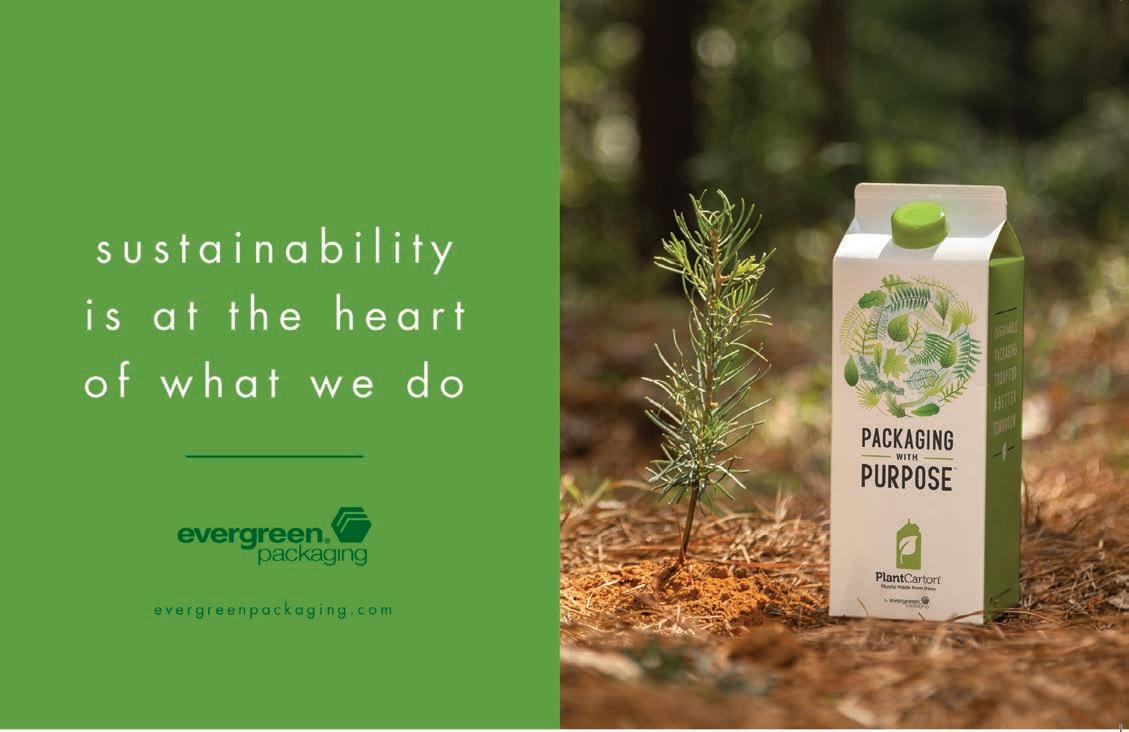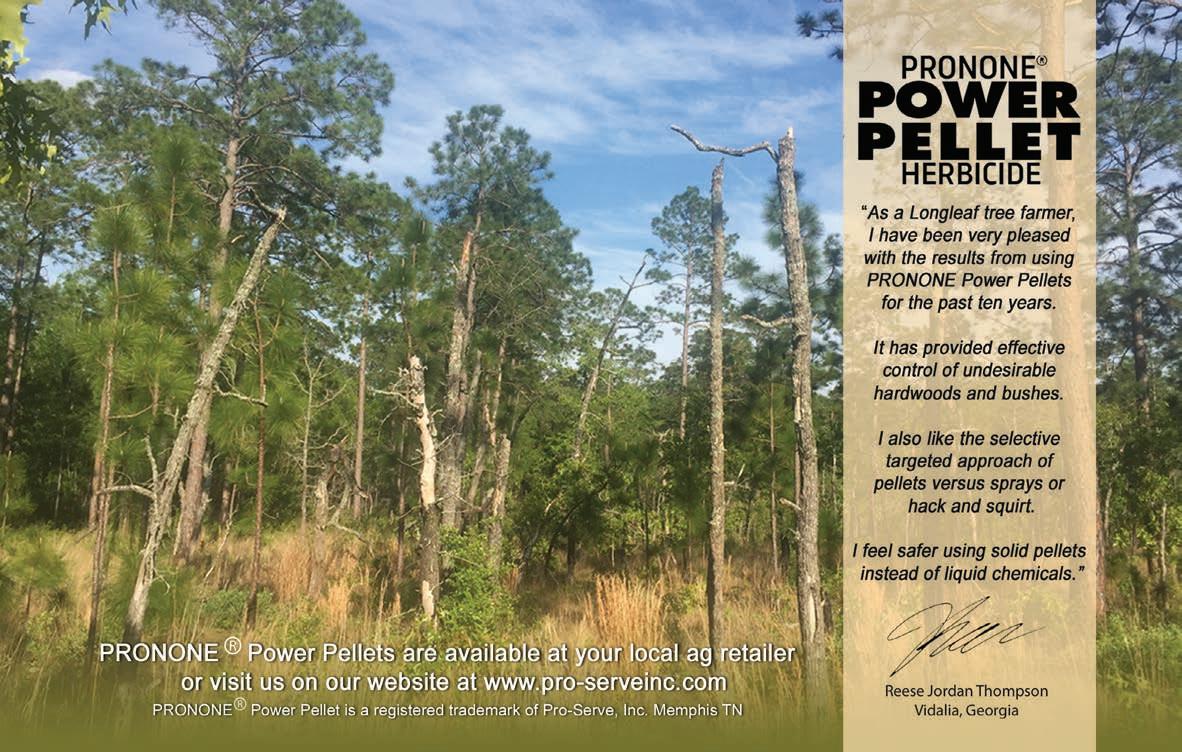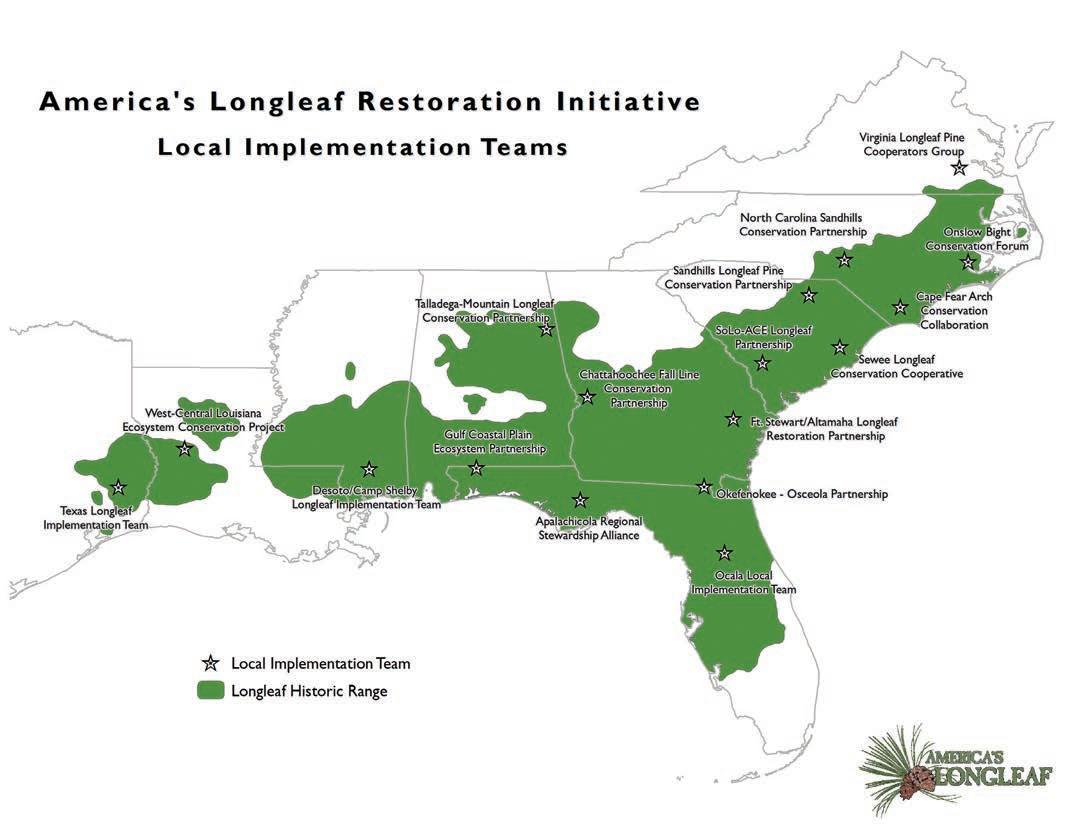
6 minute read
LANDOWNER CORNER
The Arabie family enjoys hiking their property’s extensive trails, which also serve as firebreaks. Austin Arabie took this photo prior to Hurricane Laura.
A Laura Story: Hope Among the Longleaf Pines
Advertisement

The Arabie Family's ties to their Louisiana forest land go back generations, and the sentimental value runs deep. “This land has been the passion of our family since the 1920s,” explains Austin Arabie. “It’s a way of life. It gets in your blood.” The Arabies have actively managed their land and are amazed at how the land has evolved over the years. Maintained by regular prescribed burning and a lifetime of building fire lanes and access trails, their practices have created a thriving longleaf ecosystem.
“When you talk to people about longleaf pine, many times they think of just the tree, but it is a total package,” explained Arabie. “The ecosystem the longleaf grows in is a fire-dependent system that creates a whole population of firetolerant plants around it.” The result is a diverse ecosystem that not only provides a source of income from cut timber but also establishes habitat for wildlife and offers countless hours of outdoor recreation for the entire family.
Natural Resources Conservation Service (NRCS) District Conservationist in DeRidder, Louisiana, Corby Moore, explains, “Strategically timed to mimic natural disturbance, the Arabies use fire to improve plant structure and composition as well as treating invasive species and other woody brush species’ encroachment.” Moore goes on to say, “The Arabies use prescribed burning to sculpt and improve their longleaf forest; to increase plant diversity, promote active warm-season grasses, legumes and forbs.”
Arabie agrees, “Longleaf provides a biodiverse ecosystem that’s not fully recognized by the average person. It is interesting and valuable and a great example of a fire-dependent ecosystem.”
On Thursday, August 27, 2020, that ecosystem was altered in a dramatic way when Hurricane Laura barreled through southwest Louisiana. According to the LSU AgCenter’s initial state-wide estimates, the massive impact that Laura dealt to the state was a total economic loss to the timber industry of $1.1 billion. Of that total value, $767.6 million was attributed to pine timber, while $346.9 million was attributable to hardwood timber. Vernon Parish was estimated to have experienced the most considerable economic loss at $359.7 million. Rapides, Beauregard,
A. B.

C.


A. The Arabie family’s longleaf before Hurricane Laura damage. Photo by Austin Arabie. B. The aftermath of Hurricane Laura. Photo by Amy Robertson Fuselier. C. Despite the magnitude of destruction around them, the Arabies still find reasons to smile. Gathering with their friends and family, even without water or electricity for three weeks, they often shared stories and laughter. Left to right: Corby Moore, USDA/NRCS District Conservationist, Austin Arabie, and his son, Randy Arabie. Photo by Amy Robertson Fuselier.
Grant, and Allen parishes were all estimated to have losses greater than $100 million.
Of the 720 acres of forest land the family owns, almost all the trees were damaged to some extent. After the hurricane, surveying the land revealed massive pines strewn and contorted in every shape imaginable and downed trees with exposed roots everywhere; the loss was immense. The path forward seemed uncertain. The most severely damaged was a 200acre tract of longleaf that took a direct hit. “Hurricane Laura pretty much eliminated the possibilities for prescribed burning and other management practices until we could get some of the timber off the forest floor,” said Arabie. With a heavy heart, he posed difficult questions: “How am I going to implement management practices on the land now?” and “How am I going to enjoy my property the way I have in the past?”
Moving forward
After the initial shock of Hurricane Laura wore off, and with these and so many other questions to answer, the Arabies gathered with family and friends to plan the best path forward, concentrating on what they could do, like cleaning up areas where trees still stood. Their land was home to miles and miles of forest trails and fire breaks that they used daily for hikes, not to mention access and fire lines for prescribed burning. Arabie explained, “We determined our top priority would be to clear the trails and fire lanes.” With some borrowed forestry equipment, 350 hours of chainsaw work, and an abundance of elbow grease, six miles of trails were cleared. The cleaned trails gave the Arabies access to survey the remaining damaged property and gave much-needed space for recreation.
The next step in the process was working with a timber salvage company to cut and clear timber that littered the forest floor. “After Christmas, we found a timber company that was able to salvage some of the downed trees; they were able to remove about 55 loads of timber that ultimately sold at a fraction of the cost,” explained Arabie.
Not long after the salvage operation, a significant rain event dropped eight inches of rain. “We determined that it was just too wet to continue the salvage, so work stopped,” said Arabie.
The family knew there would be management concerns associated with the salvage operation, including damaging standing trees, stressing young longleaf, and rutting up the land. “It was a trade-off, and for the long term, we had to get the downed trees cleared,” explained Arabie. “There are an estimated 300+ loads of longleaf pine logs still on the ground. Unfortunately, the chances of salvaging those decreases each day that they are on the ground.”
The future still holds several management questions for the Arabies. The greatest is how to re-introduce prescribed fire on the land safely? Although some trails, access lanes, and areas are cleared, many downed trees still dominate the landscape. With the assistance of agencies like the Natural Resources Conservation Service (NRCS) and The Longleaf Alliance (TLA), the family knows they are not alone on their path to recovery and returning to a sense of normalcy. As a 20-year member of TLA, one of the aspects of membership that Arabie values most is the continued education through its publications and articles. “I’ve learned so much. They are filled with technical and practical information that I’ve applied to our land,” he explains. With spring just around the corner, Arabie is hopeful for drier weather conditions to utilize technical guidance from the TLA and NRCS. “NRCS will be here to assist the Arabies when they are ready to begin replanting longleaf and when forest management practices are safe to begin again,” Moore described. “The Arabies are wonderful second and third-generation forest landowners who are steadfast conservationists. NRCS will be right there beside them as they rebuild their forest.”
Austin Arabie remains hopeful for positive outcomes, “We know that Hurricane Laura was an act of God. It is something that has happened a hundred times over the centuries, and we just happened to be here this time.” He smiled, “The land has recovered many times before, and we know it will recover once again.”
A wise forester once said, A soft wind blowing through longleaf pines makes a special sound; it creates beautiful music. Working together, over time, the Arabie land will be cleared and cleaned, replanted and regenerated. Many years from now, those longleaf pines will reach toward the sky, sway in the breeze, and that beautiful music will be heard once again.
For more information about NRCS programs and technical assistance, contact a local USDA/NRCS field office.
Salvaged timber, damaged in Hurricane Laura. Photo by Austin Arabie.
















